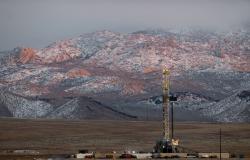Every five years, Europeans vote for the authorities that will represent them within the union. This 2024 Some 720 MEPs are elected to fight for the policies of around 450 million people. Between June 6 and 9, each of the twenty-seven members decided when citizens could use their democratic right. This Sunday is the last day of the election. What are the main challenges that the European Union (EU) will have to face in the next five years?
The European Parliament is the only transnational assembly in the world elected by direct suffrage and, therefore, has its particularities. Its members represent the different political parties of their nations. That is to say, It is an internal choice for each country and that is why it is measured internally. But once elected, legislators become part of some transnational movement to acquire power and room for maneuver. That is, they are not grouped by nationality but by ideological and political affinities.
Several people walk around a flag announcing the European elections outside the European Parliament in Brussels, on Jan. 24, 2024. (AP Photo/Virginia Mayo, File)
To be considered as a political group, a bloc must have a minimum of 23 deputies from at least seven Member States. Although there are currently seven forces, it could be said that, currently, the European Parliament is based on what they call the “European quadripartite.” That is to say, four ideological columns centered on Christian Democrats, Social Democrats, Liberals and Greens. Although depending on the results this Sunday, it could crack with the help of the far right.
According to the latest Eurobarometer published by the European Commission, The greatest concern of member countries is poverty and social inclusion. Although public health, employment, security and defense follow very closely. Geographic location is determining in their perceptions. For example, security issues are essential for those countries in northern and eastern Europe that have Russia nearby, such as Denmark, Finland, Lithuania and the Netherlands. Not so much so for Spain, which prioritizes health.
Although beyond what voters perceive, the great issue that runs through the elections of this five years is the war in Ukraine, that begins to draw different positions and new divisions. There are governments within the EU, such as that of Viktor Orban in Hungary or that of Robert Fico in Slovakia – which are closer than any of the twenty-seven – to Vladimir Putin’s Russia.
The escalation of the war in Ukraine leaves dozens dead and injured. (EFE)
Also, There are extreme right groups linked to the country of the tsars. One of them, Alternative for Germany. In these elections two of its main members were accused of being linked to a Russian propaganda network. Other European parties – which have also had extensive links with Putin – have been Marine Le Pen’s National Rally in France and Matteo Salvini’s League in Italy. Although a while ago, at least to the outside, they have distanced themselves.
Those countries geographically distant from Russia also disagree in the use of more bellicose concepts.. For example, they refuse to give way to a war economy, or to increase the economic effort for defense. These promote the idea of allocating funds, not so much for rearmament as such, but more linked to research, development and cybersecurity.
In that sense, German intelligence services have warned that Russia could target some EU country in 2026 through cyber attacks that paralyze services, infrastructures such as energy installations, telecommunications cables or even intervene through massive disinformation campaigns. The European Digital Media Observatory (EDMO) reported hundreds of disinformation attempts in recent weeks, seeking “urge people not to vote in the” European elections.
The importance of geographical location, as a vital element for the interests and concerns of a member country, is also demonstrated, for example, in the possible expansion towards the east. In that sense, it is found the proposal of Ukraine as a candidate. This has already caused friction in neighboring countries. Mainly, in Poland, where farmers have been protesting for months because, since the beginning of the Russian invasion, Ukrainian products enter the EU without tariffs and are greatly harmed.

View of the European Parliament in Brussels. (Efe)
The agricultural protests They have been a constant in recent months and have set the agenda in several Member States. The positions on this matter are found. On the one hand, Poland and France demand placing more restrictions on more Ukrainian products. Which would mean a loss of about 1.2 billion euros for kyiv. While Germany has warned of the consequences of these restrictions that could interfere with the course of the war.
Regarding the strategy to deter Putin, a historic paradigm shift is taking place in the EU. The European Investment Bank (EIB) is encouraged to change its credit policy and no longer only finance dual-use goods, such as drones or radars, but also companies that manufacture weapons and ammunition. This is a profound change in the defense industrial strategy that was neglected for years. It remains to achieve consensus.
The EU has great challenges ahead. It is going through historical changes where The war in Ukraine and the relationship with Russia are setting its course. Today they are the compass to where the destiny of the twenty-seven is heading.








